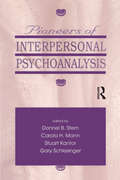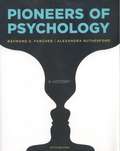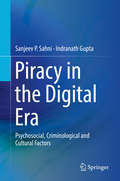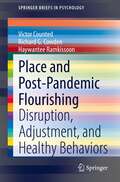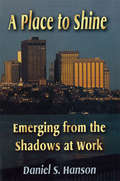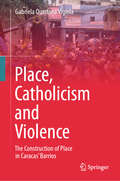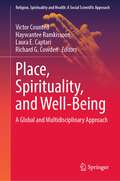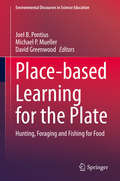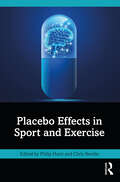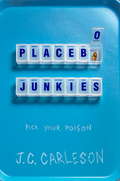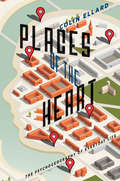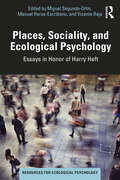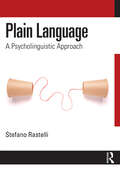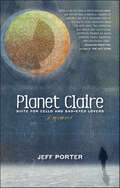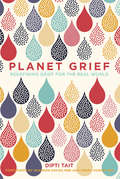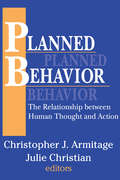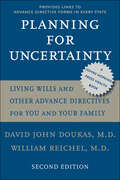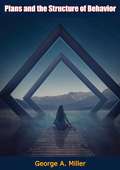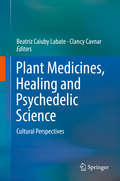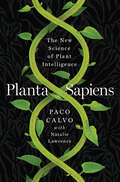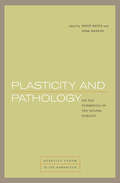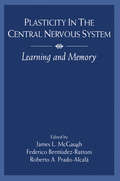- Table View
- List View
Pioneers of Interpersonal Psychoanalysis
by Donnel B. Stern Carola H. Mann Stuart Kantor Gary SchlesingerThis volume brings together 14 classic papers by interpersonal pioneers. Collectively, these papers not only demonstrate the coherence and explanatory richness of interpersonal psychoanalysis; they anticipate the emphasis on relational patterns and analyst-analysand interaction that typifies much recent theorizing. Each paper receives a substantial introduction from a leading contemporary interpersonalist.The pioneers of interpersonal psychoanalysis are: H. Sullivan, F. Fromm-Reichmann, J. Rioch, C. Thompson, R. Crowley, E. Schachtel, E. Tauber, E. Fromm, H. Bone, E. Singer, D. Schecter, J. Barnett, S. Arieti, and J.Schimel.
Pioneers of Psychology (Fifth Edition)
by Alexandra Rutherford Raymond E. FancherPioneers of Psychology tells the stories of the men and women who have shaped our understanding of what it means to be human. The authors illuminate major themes and controversies in psychology's history through carefully crafted stories of real people, their personal journeys, and their intellectual insights. The Fifth Edition includes three new chapters covering historiography, pre-1600 psychological ideas, and clinical psychology.
Pionierinnen der Psychiatrie in Frankreich und Deutschland: Sechs ausgewählte Fallstudien (Frauen in Philosophie und Wissenschaft. Women Philosophers and Scientists)
by Jana ProkopDurch die biographische Herangehensweise gewährt diese Publikation einen differenzierten und in seiner Form einzigartigen Blick auf den Werdegang ärztlicher Pionierinnen in Deutschland und Frankreich von 1870 bis 1945. Dargestellt werden die Lebensläufe von sechs Psychiaterinnen, diese sind eingebettet in eine vergleichende Psychiatriegeschichte beider Länder mit besonderem Augenmerk auf die Entwicklungen der Psychiatrie in Zeiten des Zweiten Weltkrieges. Informationen zum Hochschulzugang von Frauen, dem Medizinstudium der ersten Studentinnen, zu Forschung sowie weiblicher Berufstätigkeit von Ärztinnen in beiden Ländern runden das Werk ab.
Piracy in the Digital Era: Psychosocial, Criminological and Cultural Factors
by Indranath Gupta Sanjeev P. SahniThis book builds an empirical basis towards creating broader prevention and intervention programs in curbing digital piracy. It addresses the psychosocial, cultural and criminological factors associated with digital piracy to construct more efficient problem-solving mechanisms. Digital piracy including online piracy involves illegal copying of copyrighted materials. This practice costs the software industry, entertainment industry, and governments billions of dollars every year. Reports of the World Intellectual Property Organization (WIPO) and Business Software Alliance (BSA) view piracy largely in the light of economic factors; the assumption being that only those who cannot afford legitimate copies of software, music, and movies indulge in it. Drawing on research and theories from various disciplines like psychology, sociology, criminology, and law, the authors have designed an empirical study to understand the contribution of psychological, cultural and criminological factors to digital piracy. The chapters include data from India and China, which continue to be on the Special 301 report priority watch list of the WIPO, and Serbia, which has been on the watch list 4 times. They examine the role of self-control, self-efficacy, perceived punishment severity, awareness about digital piracy, peer influence, neutralization techniques, novelty seeking, pro-industry factors and other socio-demographic factors in predicting digital piracy. This book addresses a large readership, comprising academics and researchers in psychology, criminology and criminal justice, law and intellectual property rights, social sciences, and IT, as well as policymakers, to better understand and deal with the phenomenon of digital piracy.
Place and Post-Pandemic Flourishing: Disruption, Adjustment, and Healthy Behaviors (SpringerBriefs in Psychology)
by Haywantee Ramkissoon Victor Counted Richard G. CowdenThis book rekindles the well-known connection between people and place in the context of a global pandemic. The chapters are divided into two sections. In the first section, “Place Attachment During a Pandemic,” we review the nature of the COVID-19 pandemic and the extent of its impact on place attachment and human-environment interactions. We examine how restrictions in mobility and environmental changes can have a significant psychological burden on people who are dealing with the effect of place attachment disruption that arises during a pandemic. In the second section, “Adjusting to Place Attachment Disruption During and After a Pandemic,” we focus on adaptive processes and responses that could enable people to adjust positively to place attachment disruption. We conclude the book by discussing the potential for pro-environmental behavior to promote place attachment and flourishing in the aftermath of the COVID-19 pandemic by introducing an integrative framework of place flourishing and exploring its implications for theory, research, policy, and practice.
Place to Shine, A: Bringing Special Gifts To Light
by Arden Hills Daniel S HansonFirst published in 1996. Routledge is an imprint of Taylor & Francis, an informa company.
Place, Catholicism and Violence: The Construction of Place in Caracas’ Barrios
by Gabriela Quintana VigiolaThis book explores the interwoven nature of place, Catholicism and violence in Caracas’ barrios. Using interdisciplinary perspectives to investigate themes of urban space, meaning as a psychosocial construct, criminal violence, and religiosity as culture, this book uncovers the underlying complexities of turning spaces into places through the built form, activities in the urban space and the meanings associated with it. Fundamental elements in the construction of place are used to understand the ways in which barrio residents conceive and construct the physicality of the private, public and religious spaces; how residents use the physical spaces of the barrios; and the psychosocial meanings residents associate with the spaces and activities. Using rich qualitative data and a case study design, the book relies on audio-visual data and interviews with organisers, residents and key participants in Petare, the largest barrio conglomeration in Caracas and Venezuela. Qualitative thematic analysis of participants’ experiences of Catholicism, violence and, ultimately, the construction of place exposes a unique argument: that meaningful urban spaces are embedded with emotions, memories, relationships, experiences and meanings, which turn them into places.
Place, Spirituality, and Well-Being: A Global and Multidisciplinary Approach (Religion, Spirituality and Health: A Social Scientific Approach #7)
by Haywantee Ramkissoon Victor Counted Richard G. Cowden Laura E. CaptariThis book synthesizes perspectives on how ‘place’ is deeply intertwined with our spirituality and well-being. Split into three sections, this book brings together contributions from global scholars across a range of disciplines to unravel how the personal, social, and cultural spheres of place shape our spiritual experiences and overall well-being. It is an essential read for those interested in enriching their knowledge of the linkages between place, spirituality, and well-being, while also providing a foundation for future research on place and its intersections with both spirituality and well-being.
Place-based Learning for the Plate: Hunting, Foraging and Fishing for Food (Environmental Discourses in Science Education #6)
by Michael P. Mueller David Greenwood Joel B. PontiusThis edited volume explores 21st century stories of hunting, foraging, and fishing for food as unique forms of place-based learning. Through the authors’ narratives, it reveals complex social and ecological relationships while readers sample the flavors of foraging in Portland, Oregon; feel some of what it’s like to grow up hunting and gathering as a person of Oglala Lakota and Shoshone-Bannock descent; track the immersive process of learning to communicate with rocky mountain elk; encounter a road-killed deer as a spontaneous source of local meat, and more.Other topics in the collection connect place, food, and learning to issues of identity, activism, spirituality, food movements, conservation, traditional and elder knowledge, and the ethics related to eating the more-than-human world. This volume will bring lively discussion to courses on place-based learning, food studies, environmental education, outdoor recreation, experiential education, holistic learning, human dimensions of natural resource management, sustainability, food systems, environmental ethics, and others.
Placebo Effects in Sport and Exercise
by Philip Hurst Chris BeediePlacebo effects have been recognised by medicine and by science, yet only recently has systematic research begun to fully understand what they are and how they work. Sport and exercise scientists started systematic research to better understand the potential performance-enhancing effects of placebos as well as how a range of treatments are used in sport, from nutritional supplements to psychological interventions to sports medicine treatments. Placebo Effects in Sport and Exercise synthesises this field of research of the influence placebo effects have in sport and exercise. This book brings together many of the world’s leading and emerging placebo effect researchers to help readers gain an understanding of core research findings from within sports and exercise science as well as sport and exercise-related contributions from experts in anthropology, medicine, and neuroscience. Readers will gain an insight of what placebo and nocebo effects are, how they might influence sport and exercise performance and outcomes, and how they might significantly influence the effectiveness of performance and health interventions. The book investigates various practical and ethical implications for the sport and exercise practitioner, student, and researcher to consider. Can a placebo work if the athlete knows it’s a placebo? Should practitioners use placebos to enhance performance? Can the use of placebos reduce doping? Are some sports medicine treatments little more than placebos? With the rapid growth of applied sports medicine, as well as the concept of exercise as a mental health treatment in its own right, Placebo Effects in Sport and Exercise is key reading for students and researchers of sport psychology as well as those out in the field.
Placebo Junkies
by J. C. CarlesonGoing Bovine meets Trainspotting in this gritty portrait of at-risk teens gaming the prescription drug trial system. Meet Audie: Professional lab rat. Guinea pig. Serial human test subject. For Audie and her friends, "volunteering" for pharmaceutical drug trials means a quick fix and easy cash. Sure, there's the occasional nasty side effect, but Audie's got things under control. If Monday's pill causes a rash, Tuesday's ointment usually clears it right up. Wednesday's injection soothes the sting from Tuesday's "cure," and Thursday's procedure makes her forget all about Wednesday's headache. By the time Friday rolls around, there's plenty of cash in hand and perhaps even a slot in a government-funded psilocybin study, because WEEKEND! But the best fix of all is her boyfriend, Dylan, whose terminal illness just makes them even more compatible. He's turning eighteen soon, so Audie is saving up to make it an unforgettable birthday. That means more drug trials than ever before, but Dylan is worth it. No pain, no gain, Audie tells herself as the pills wear away at her body and mind. No pain, no gain, she repeats as her grip on reality starts to slide. . . . Raw and irreverent, Placebo Junkies will captivate readers until the very end, when author J. C. Carleson leans in for a final twist of the knife.
Places of the Heart
by Colin EllardA Selection of the Library of Science, History, and Military Book Clubs"One of the finest science writers I've ever read." -Los Angeles Times"Ellard has a knack for distilling obscure scientific theories into practical wisdom." -New York Times Book Review"[Ellard] mak[es] even the most mundane entomological experiment or exegesis of psychological geekspeak feel fresh and fascinating." -NPR"Colin Ellard is one of the world's foremost thinkers on the neuroscience of urban design. Here he offers an entirely new way to understand our cities-and ourselves." -CHARLES MONTGOMERY, author of Happy City: Transforming Our Lives Through Urban DesignOur surroundings can powerfully affect our thoughts, emotions, and physical responses, whether we're awed by the Grand Canyon or Hagia Sophia, panicked in a crowded room, soothed by a walk in the park, or tempted in casinos and shopping malls. In Places of the Heart, Colin Ellard explores how our homes, workplaces, cities, and nature-places we escape to and can't escape from-have influenced us throughout history, and how our brains and bodies respond to different types of real and virtual space. As he describes the insight he and other scientists have gained from new technologies, he assesses the influence these technologies will have on our evolving environment and asks what kind of world we are, and should be, creating.Colin Ellard is the author of You Are Here: Why We Can Find Our Way to the Moon, but Get Lost in the Mall. A cognitive neuroscientist at the University of Waterloo and director of its Urban Realities Laboratory, he lives in Kitchener, Ontario.
Places, Sociality, and Ecological Psychology: Essays in Honor of Harry Heft (Resources for Ecological Psychology Series)
by Manuel Heras-Escribano Miguel Segundo-Ortin Vicente RajaThis book presents a collection of essays honoring Professor Harry Heft, a leading figure in the field of ecological psychology, engaging critically with his work, thought and influence. Containing 12 chapters written by leading experts from philosophy and psychology, this text critically examines, questions, and expands on crucial ideas from Heft concerning the nature of cognition, its relationship to the body and the environment (including the social and cultural environment), and the main philosophical assumptions underlying the scientific study of psychological functions. It elaborates on the notion of affordance, and its connection to social, cultural and developmental psychology, as well as on the application of Roger Barker’s eco-behavioral program for current psychology and cognitive science. The book includes an extensive interview with Heft, where he reflects about the history, challenges and future of ecological psychology. Finally, it presents a chapter written by Heft, that offers a systematic response to the critical feedback. Given the increasing popularity of ecological psychology and the highly influential work of Harry Heft in related areas such as developmental, social and cultural psychology, and philosophy, this book will appeal to all those interested in the cognitive sciences from a scientific and philosophical perspective. It is also a must read for students of psychology, philosophy, and cognitive science departments.
Plain Language: A Psycholinguistic Approach
by Stefano RastelliPlain Language: A Psycholinguistic Approach employs principles from the field of psycholinguistics to explore factors that make a sentence or text easy or difficult to process by the cognitive mechanisms that support language processing, and describes how levels of difficulty might function within bureaucratic power structures.Drawing from experimental data on readability, the author employs a metaphor of three "ghost" readers in the mind that exist and interact with each other: the syntactic reader (the one searching for the structure), the statistical reader (the one driven by previous experiences), and finally the pragmatic reader (the one searching for meaning). The penultimate chapter concerns a novel psycholinguistic experiment showing that complexly written texts may prevent adult citizens with average literacy skills from accessing important information related to their health, work, and right to representation, thereby drawing a line between the psycholinguistics of language comprehension and the maintenance of existing power structures.Written in plain language itself, this book is designed to be easily understandable from an undergraduate level and makes for fascinating reading for all students and researchers in linguistics and psycholinguistics, as well as supplementary reading for students of sociolinguistics and related modules. Students, researchers, and interested general readers will develop an understanding that knowing how the mind reads and understands language can help stakeholders to ensure equal access to information and democratic processes.
Planet Claire, Suite for Cello and Sad-Eyed Lovers: A Memoir
by Jeff PorterThe second installment in Ann Hood’s Gracie Belle imprint challenges the traditional solemnity that characterizes nonfiction books of grief, loss, and sorrow.“Few readers will fail to be gripped by this tragically common story about death and what comes after for those left behind . . . A haunting and thought-provoking consideration of death and ‘how utterly it rips apart our lives.'” —Kirkus Reviews, Starred ReviewPlanet Claire is the story of the untimely death of the author’s wife and his candid account of the following year of madness and grief. As his life unravels, Porter analyzes his sadness with growing interest. He talks to Claire as if to evoke a presence, to mark a space for memory. He reports on his daily walks and shares observations of life’s sadness, while reminiscing about various moments in their life together. Like Orpheus, the author searches for a lost love, and what he finds is not the dog of doom but flashes of an intimate symmetry that brighten the darkest places of sorrow.The second title from Ann Hood’s Gracie Belle imprint, Planet Claire takes readers on a journey of sorrow that recalls memorable works by C.S. Lewis (A Grief Observed), Joan Didion (The Year of Magical Thinking), and Julian Barnes (Levels of Life). Porter’s memoir, however, is also playful, quirky, and self-ironic in a way that challenges the genre’s traditional solemnity. Like the novel Grief Is the Thing with Feathers by Max Porter, this is an unpredictably funny account of heartbreak, as if to say there’s something about the magnitude of loss that troubles even earnestness.
Planet Cosplay: Costume Play, Identity And Global Fandom
by Anne Peirson-Smith Adam Geczy Paul MountfortThis book examines cosplay from a set of ground-breaking disciplinary approaches, highlighting the latest and emerging discourses around this popular cultural practice. Planet Cosplay is authored by widely-published scholars in this field, examining the central aspects of cosplay ranging from sources and sites to performance and play, from sex and gender to production and consumption. Topics discussed include the rise of cosplay as a cultural phenomenon and its role in personal, cultural, and global identities. Planet Cosplay provides a unique, multifaceted examination of the practice from theoretical bases including popular cultural studies, performance studies, gender studies, and transmedia studies. As the title suggests, the book’s purview is global, encompassing some of the main centers of cosplay throughout the United States Asia Europe and Australasia. Each of the chapters offers not only a set of entry points into its subject matter, but also a narrative of the development of cosplay and scholarly approaches to it.
Planet Grief: Redefining Grief for the Real World
by Penny Power Dipti Tait Sharron DaviesWe all grieve. From the moment we are born into this cold, loud, bright world, we experience change and loss that can often threaten to overwhelm us, but – when managed well – can help mould us into our strongest, most powerful selves.Grief is not only about death: it is part of our everyday lives. We are all grieving something. We grieve when our life changes – when meaningful relationships end, when we move house, change schools or jobs, and when our sense of identity and reality are under threat. We also grieve on a larger level – for a lost way of life and for our planet, particularly in these times of climate crisis, pandemic, fast-moving technology, misinformation and societal division. Grief can even be found in joy and is one of the most universal shared emotions, connecting people across the world in an act of love.In this surprisingly uplifting book, acclaimed grief therapist Dipti Tait draws on her own professional and personal experiences, her clients’ stories and the neuroscience behind our emotions to redefine grief for our fast-paced lives and this sometimes alarming yet wonderful world we live in.
Planned Behavior: The Relationship between Human Thought and Action
by Mason GrossPsychologists regard the relationship between attitudes and behavior as a key to understanding human behavior. Here leading researchers discuss basic and applied issues relating to how human thought translates into action. The contributors focus on the theory of planned behavior, a model of attitude-behavior relations that takes into account not just attitudes, but also the influence of significant others around us, issues of personal agency, and motivation. The book begins with an overview of the theory of planned behavior, from the initial impetus to better understand attitude-behavior relations, through the theory of reasoned action, to the theory of planned behavior. Among the applied issues discussed in subsequent chapters are using the model to predict homeless persons' use of services, understanding the motivation underpinning suicide in an at-risk sample, and experimentally manipulating antecedents of risky driving behavior. More methodologically oriented chapters explore how the theory of planned behavior may be developed in the future. Several chapters discuss the potential integration of the theory of planned behavior with social identity theory and goal theory; other chapters discuss the key components of the theory of planned behavior and whether the theory might usefully be extended with the concept of descriptive norms. This book considers a full spectrum of important developments that enhance our understanding of the theory of planned behavior and efforts to extend it. From applications to new avenues for research, the chapters that make up this book address important issues surrounding theoretical and practical approaches to addressing problems in attitude-behavior research.
Planning for Uncertainty: Living Wills and Other Advance Directives for You and Your Family (A Johns Hopkins Press Health Book)
by William Reichel David John DoukasIt won’t happen to me.I’m too busy to worry about a living will.My family will know what to do.No one wants to plan for death or incapacitating illness. But, as the emotional legal battle in the Terri Schiavo case made all too clear, people of all ages need to document and communicate clear decisions about the final details of their lives while they are healthy and have time to fully consider their own values and preferences.Here, Drs. David Doukas and William Reichel help individuals make decisions and communicate their wishes to health care providers and family members and other loved ones.Drs. Doukas and Reichel use a question-and-answer format to guide readers through the process—emphasizing the crucial connection between values and treatment preferences. They explain advance directives and the health care decision-making process, including the values history, family covenants, proxies, and proxy negation. The appendix includes resources and Web links for learning about advance directive requirements and obtaining legal forms in all fifty states.This practical guide helps people navigate the important but often intimidating process of thinking about, and planning for, an uncertain future.
Plans and the Structure of Behavior
by George A. Miller Eugene GalanterBy 1960, psychology had come to be dominated by behaviorism and learning theory, which emphasized the observable stimulus and response components of human and animal behavior while ignoring the cognitive processes that mediate the relationship between the stimulus and response. The cognitive phenomena occurring within the "black box" between stimulus and response were of little interest to behaviorists, as their mathematical models worked without them. In 1960, the book "Plans and the Structure of Behavior," authored by George A. Miller, Eugene Galanter, and Karl H. Pribram, was published. In this volume, Miller and his colleagues sought to unify the behaviorists' learning theory with a cognitive model of learned behavior. Whereas the behaviorists suggested that a simple reflex arc underlies the acquisition of the stimulus-response relationship, Miller and his colleagues proposed that "some mediating organization of experience is necessary" somewhere between the stimulus and response, in effect a cognitive process which must include monitoring devices that control the acquisition of the stimulus-response relationship. They named this fundamental unit of behavior the T.O.T.E. for "Test - Operate - Test - Exit".—Print ed.
Plant Medicines, Healing and Psychedelic Science: Cultural Perspectives
by Beatriz Caiuby Labate Clancy CavnarThis is a book about the intersections of three dimensions. The first is the way social scientists and historians treat the history of psychiatry and healing, especially as it intersects with psychedelics. The second encompasses a reflection on the substances themselves and their effects on bodies. The third addresses traditional healing, as it circles back to our understanding of drugs and psychiatry. The chapters explore how these dimensions are distinct, but deeply intertwined, themes that offer important insights into contemporary healing practices.The intended audience of the volume is large and diverse: neuroscientists, biologists, medical doctors, psychiatrists, psychologists; mental health professionals interested in the therapeutic application of psychedelic substances, or who work with substance abuse, depression, anxiety, and PTSD; patients and practitioners of complementary and alternative medicine; ethnobotanists and ethnopharmacologists; lawyers, criminologists, and other specialists in international law working on matters related to drug policy and human rights, as well as scholars of religious studies, anthropologists, sociologists, and historians; social scientists concerned both with the history of science, medicine, and technology, and concepts of health, illness, and healing. It has a potentially large international audience, especially considering the increasing interest in “psychedelic science” and the growing spread of the use of traditional psychoactives in the West.
Planta Sapiens: The New Science of Plant Intelligence
by Paco Calvo“Weaves science and history into an absorbing exploration of the many ways that plants rise to the challenge of living.” —Merlin Sheldrake, author of Entangled Life An astonishing window into the inner world of plants, and the cutting-edge science in plant intelligence. Decades of research document plants’ impressive abilities: they communicate with each other, manipulate other species, and move in sophisticated ways. Lesser known, however, is that although plants may not have brains, their internal workings reveal a system not unlike the neuronal networks running through our own bodies. They can learn and remember, possessing an intelligence that allows them to behave in flexible, forward-looking, and goal-directed ways. In Planta Sapiens, Paco Calvo, a leading figure in the philosophy of plant signaling and behavior, offers an entirely new perspective on plants’ worlds, showing for the first time how we can use tools developed to study animal cognition in a quest to understand plant intelligence. Plants learn from experience: wild strawberries can be taught to link light intensity with nutrient levels in the soil, and flowers can time pollen production to pollinator visits. Plants have social intelligence, releasing chemicals from their roots and leaves to speak to and identify one another. They make decisions about where to invest their growth, judging risk based on the resources available. Their individual preferences vary, too—plants have personalities. Calvo also illuminates how plants inspire technological advancements, from robotics to AI. Most importantly, he demonstrates that plants are not objects: they have their own agency. If we recognize plants as actors alongside us in the climate crisis—rather than seeing them simply as resources for carbon capture and food production—plants may just be able to help us tackle our most urgent problems.
Plasticity and Pathology: On the Formation of the Neural Subject (Berkeley Forum In The Humanities Ser.)
by David Bates Nima BassiriTwo leading neuroscientists examine the current paradigm of the &“neural subject&” and what we can learn from neurological trauma, pathology, and adaption. With the rise of cognitive science and the revolution in neuroscience, the study of human subjects—thinking, feeling, acting individuals—ultimately focuses on the human brain. In both Europe and the United States, massive state-funded research is focused on mapping the brain in all its remarkable complexity. The metaphors employed are largely technological, using a diagram of synaptic connectivity as a path to understanding human behavior. But alongside this technologized discourse, we find another perspective, one that emphasizes the brain&’s essential plasticity, both in development and as a response to traumas such as strokes, tumors, or gunshot wounds. This collection of essays brings together a diverse range of scholars to investigate how the &“neural subject&” of the twenty-first century came to be. Taking approaches both historical and theoretical, they probe the possibilities and limits of neuroscientific understandings of human experience. Topics include landmark studies in the history of neuroscience, the relationship between neural and technological &“pathologies,&” and analyses of contemporary concepts of plasticity and pathology in cognitive neuroscience. Central to the volume is a critical examination of the relationship between pathology and plasticity. Because pathology is often the occasion for neural reorganization and adaptation, it exists not in opposition to the brain&’s &“normal&” operation but instead as something intimately connected to our ways of being and understanding.
Plasticity in Sensory Systems
by Jennifer K. E. Steeves Laurence R. HarrisCentered on three themes, this book explores the latest research in plasticity in sensory systems, focusing on visual and auditory systems. It covers a breadth of recent scientific study within the field including research on healthy systems and diseased models of sensory processing. Topics include visual and visuomotor learning, models of how the brain codes visual information, sensory adaptations in vision and hearing as a result of partial or complete visual loss in childhood, plasticity in the adult visual system, and plasticity across the senses, as well as new techniques in vision recovery, rehabilitation, and sensory substitution of other senses when one sense is lost. This unique edited volume, the fruit of an International Conference on Plastic Vision held at York University, Toronto, will provide students and scientists with an overview of the ongoing research related to sensory plasticity and perspectives on the direction of future work in the field.
Plasticity in the Central Nervous System: Learning and Memory
by James L. McGaugh Federico Bermúdez-Rattoni Roberto A. Prado-AlcaláCatalyzed by the development of new neurobiological and behavioral techniques as well as new conceptual and theoretical approaches to the study of the relationship between brain and behavior, research exploring brain functions enabling learning and memory has greatly accelerated in recent years. The chapters in this book reflect current theoretical approaches to the study of brain and memory and provide new insights concerning the cellular bases of memory and the differential involvement of brain systems in different forms of memory. By presenting up-to-date summaries of research investigating brain mechanisms underlying learning and memory, these chapters help to place current findings in appropriate theoretical context, and further stimulate research inquiry attempting to understand how the brain makes memory. Divided into three sections, coverage in this volume includes: * a discussion of pharmacological approaches to the study of brain and memory; * a review of experiments using a variety of techniques, including brain lesions, brain grafting, and electrophysiological recording to investigate the role of different brain regions in learning and memory; and * an examination of molecular analyses of events associated with memory formation.
